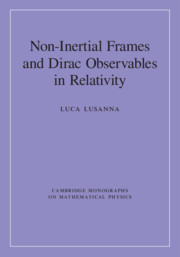
-
Select format
-
- Publisher:
- Cambridge University Press
- Publication date:
- June 2019
- July 2019
- ISBN:
- 9781108691239
- 9781108480826
- Dimensions:
- (247 x 174 mm)
- Weight & Pages:
- 0.77kg, 336 Pages
- Dimensions:
- Weight & Pages:
You may already have access via personal or institutional login
Book description
Interpreting general relativity relies on a proper description of non-inertial frames and Dirac observables. This book describes global non-inertial frames in special and general relativity. The first part covers special relativity and Minkowski space time, before covering general relativity, globally hyperbolic Einstein space-time, and the application of the 3+1 splitting method to general relativity. The author uses a Hamiltonian description and the Dirac–Bergmann theory of constraints to show that the transition between one non-inertial frame and another is a gauge transformation, extra variables describing the frame are gauge variables, and the measureable matter quantities are gauge invariant Dirac observables. Point particles, fluids and fields are also discussed, including how to treat the problems of relative times in the description of relativistic bound states, and the problem of relativistic centre of mass. Providing a detailed description of mathematical methods, the book is perfect for theoretical physicists, researchers and students working in special and general relativity.
Reviews
'The book is very much a technical monograph, with very detailed mathematical descriptions that will need careful study to make best use of it. It is not always an easy read, but rather a formidable tour-de-force that will primarily be for experts in the field.'
Alan Heavens Source: The Observatory
‘This book is devoted to making an extensive and very detailed study of the relationship between these topics and showing their application to relativistic particle systems, fluids and field theories in inertial and non-inertial systems. In this sense, as the author himself describes in the preface, it becomes clear that the transitions between non-inertial frames are gauge transformations, that extra variables are gauge variables, and that the measurable matter quantities are gauge invariant Dirac observables. The last part of the book (two chapters) is devoted to presenting a very thorough review of the Dirac-Bergmann theory of constrained systems … The book also includes three appendices that clarify some aspects and tools used in the exposition, a presentation of conclusions and a brief discussion on some of the main open problems among which, obviously, the quantization of fields in non-inertial frames stands out.’
Narciso Roman-Roy Source: Mathematical Reviews/MathSciNet
Contents
Metrics
Full text views
Full text views help Loading metrics...
Loading metrics...
* Views captured on Cambridge Core between #date#. This data will be updated every 24 hours.
Usage data cannot currently be displayed.
Accessibility standard: Unknown
Why this information is here
This section outlines the accessibility features of this content - including support for screen readers, full keyboard navigation and high-contrast display options. This may not be relevant for you.
Accessibility Information
Accessibility compliance for the PDF of this book is currently unknown and may be updated in the future.


